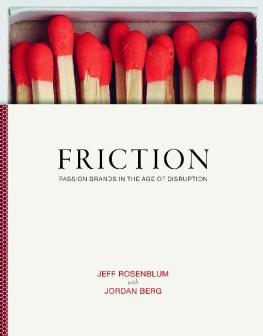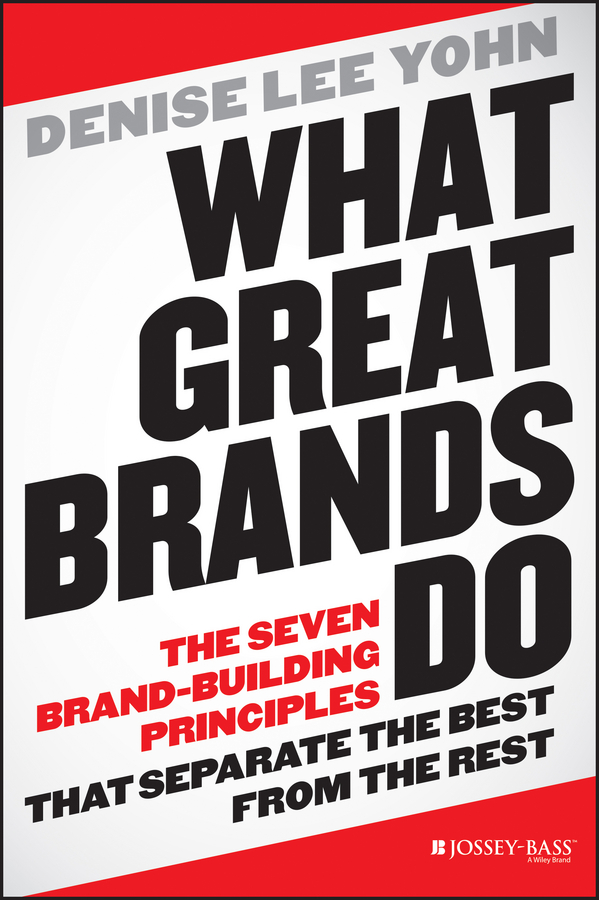Contents
Praise for What Great Brands Do
If, like me, youve never been a brand person, let Denise Lee Yohn be your guide in building your brand into your business. Follow her principles, embrace her tools, and execute through every single thing you do. As she taught me, thats what great brands do.
B. Joseph Pine II , coauthor, The Experience Economy and Authenticity
While brands have become increasingly complex and challenging to manage, Denise has done a terrific job of breaking down what matters in building brands that dont just thrive, but win.
Scott Davis , chief growth officer, Prophet, and author, Building the Brand-Driven Business

Copyright 2014 by Denise Lee Yohn, Inc. All rights reserved.
Published by Jossey-Bass
A Wiley Brand
One Montgomery Street, Suite 1200, San Francisco, CA 94104-4594 www.josseybass.com
No part of this publication may be reproduced, stored in a retrieval system, or transmitted in any form or by any means, electronic, mechanical, photocopying, recording, scanning, or otherwise, except as permitted under Section 107 or 108 of the 1976 United States Copyright Act, without either the prior written permission of the publisher, or authorization through payment of the appropriate per-copy fee to the Copyright Clearance Center, Inc., 222 Rosewood Drive, Danvers, MA 01923, 978-750-8400, fax 978-646-8600, or on the Web at www.copyright.com . Requests to the publisher for permission should be addressed to the Permissions Department, John Wiley & Sons, Inc., 111 River Street, Hoboken, NJ 07030, 201-748-6011, fax 201-748-6008, or online at www.wiley.com/go/permissions .
Limit of Liability/Disclaimer of Warranty: While the publisher and author have used their best efforts in preparing this book, they make no representations or warranties with respect to the accuracy or completeness of the contents of this book and specifically disclaim any implied warranties of merchantability or fitness for a particular purpose. No warranty may be created or extended by sales representatives or written sales materials. The advice and strategies contained herein may not be suitable for your situation. You should consult with a professional where appropriate. Neither the publisher nor author shall be liable for any loss of profit or any other commercial damages, including but not limited to special, incidental, consequential, or other damages. Readers should be aware that Internet Web sites offered as citations and/or sources for further information may have changed or disappeared between the time this was written and when it is read.
Jossey-Bass books and products are available through most bookstores. To contact Jossey-Bass directly call our Customer Care Department within the U.S. at 800-956-7739, outside the U.S. at 317-572-3986, or fax 317-572-4002.
Wiley publishes in a variety of print and electronic formats and by print-on-demand. Some material included with standard print versions of this book may not be included in e-books or in print-on-demand. If this book refers to media such as a CD or DVD that is not included in the version you purchased, you may download this material at http://booksupport.wiley.com . For more information about Wiley products, visit www.wiley.com .
Library of Congress Cataloging-in-Publication Data
Yohn, Denise Lee, 1967
What great brands do : the seven brand-building principles that separate the best from the rest / Denise Lee Yohn.
pages cm
Includes bibliographical references and index.
ISBN 978-1-118-61125-8 (cloth); ISBN 9781118824405 (ePDF); ISBN 9781118824337 (ePub)
1. Branding (Marketing) 2. Brand name products. I. Title.
HF5415.1255.Y64 2014
658.827dc23
2013032239
For Chris
Introduction
The most important lesson of history, its been said, is that people dont learn very much from history. That thought has occurred to me at times when Ive heard the offhand comment that Kodak, one of the greatest brands on Earth not that long ago, was ruined by the digital camera. Anyone who believes that a great brand can be undone by mere changes in technology doesnt fully understand what makes great brands great.
Kodak ranked as one of the four most valuable brands in the world in 1996, just behind Disney, Coca-Cola, and McDonalds. It had earned that ranking after decades of being the dominant U.S. maker of affordable cameras and photographic film. Kodak was known as Americas storyteller, and its advertising delivered powerfully memorable messages such as Kodak, for the times of your life. The Kodak moment even became a pop-culture catchphrase. Kodaks name was seared into the publics consciousness as being synonymous with good times and fond memories.
When Kodak filed for bankruptcy in 2012, it had lost $30 billion in market value in the fourteen short years since its profits peaked in 1999. The cause of Kodaks stunning fall has been attributed to claims that Kodak was too slow to move to digital photography, and that it failed to make quality digital-age products. Poor strategic planning, lack of foresight, and inept product development and design have all been claimed as contributing factors.
There is no question that digital photography eroded Kodaks high-profit film and developing businesses. But what if Kodaks many inadequate responses to this challenge were mere symptoms of a deeper problem at Kodak? What if all of the companys disappointments and failures during its years of decline were really rooted in one central failurea failure to follow through on an integral brand strategy? What if Kodak failed simply because Kodak no longer did what great brands do?
This book is an examination of how great brands manage to avoid the fate of Kodak and other faded companies by using their brands as management tools to fuel, align, and guide every person in the organization and every task they undertake. I show how companies as diverse as IBM, REI, Starbucks, and IKEA have all successfully relied on a management approach that drives their culture, company operations, and customer experiencesan approach I call brand as business. With brand as business, the brand is the central organizing and operating idea of the business. Great brands use the brand-as-business management approach to grow and succeed in tough economic climates, regardless of the size of their marketing budgets. The seven guiding principles of What Great Brands Do and their accompanying action steps and exercises provide a step-by-step methodology for putting your companys brand where it belongsin the drivers seat of your organization.
Beyond Advertising: Brand as Business
As companies with great brands demonstrate, brand building is in no way confined to advertising and marketing. The proliferation of social networks and the pervasiveness of marketing in recent years may give the impression that companies should elevate the brand communication function, but growth in brand equity and influence comes from an entirely different way of thinking about and using brands. Brand building involves operationalizing the brand as an integral way of managing and growing a business. So this book is for business leaders, owners, and general managersthe people who drive the culture, core operations, and customer experiences of an organization. These are the people who can ensure their companies unleash the full potential of their brands.
The trouble is that most companies dont view their brand this way at all. Most leaders dont realize that they need to operationalize their brand. Thats because brands are often misunderstood or misrepresented. The idea of brand is more often perceived as a tool for appealing to external audiencesin marketing, PR, maybe even sales. Ive heard people define a brand as a companys name, logo, image, advertising, aura, personality, look and feel, attitude, reputation, or trademark.










